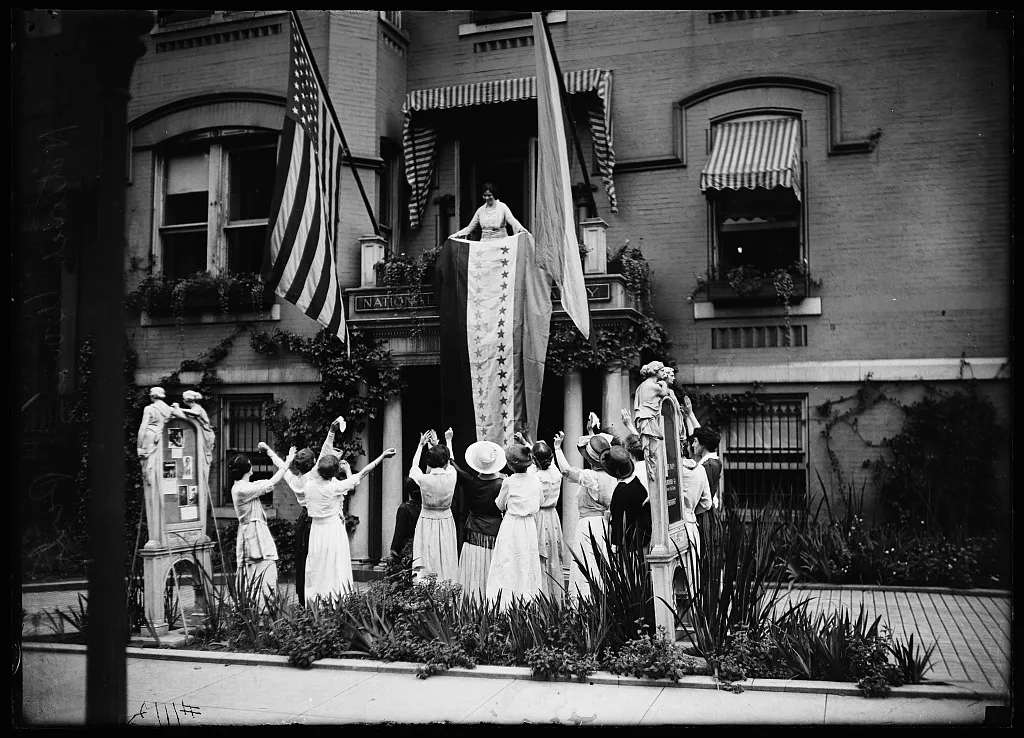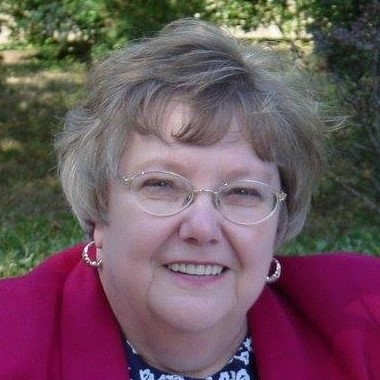
The Perfect 36
On June 4, 1919, the 66th Congress achieved the two-thirds majority required for the passage of the 19th Amendment to the United States Constitution. First introduced to the 45th Congress in 1878, this triumph was the culmination of over 70 years of struggle by four generations of organized women.
Owing partly to aggressive, relentless, and public agitation in recent years, and partly to women’s efforts on behalf of the Great War, in 1918 President Woodrow Wilson altered his previous position against woman suffrage to urge Congress to support the amendment as a war measure, a reward for the loyal support of the nation’s women. He based his two-pronged entreaty upon the matters of fairness for women and America’s role in the post-war world.
We have made partners of the women in this war; shall we admit them only to a partnership of sacrifice and suffering and toil and not to a partnership of privilege and of right? This war could not have been fought, either by the other nations engaged or by America, if it had not been for the services of the women….The world is watching us, looking to the great, powerful, famous democracy of the West to lead them to the new day…and they think, in their logical simplicity, that democracy means that women shall play their part in affairs alongside men and upon equal footing with them. If we reject measures like this, in ignorance or defiance of what a new age has brought forth, they will cease to follow or to trust us.
The House of Representatives voted in favor of the 19th Amendment in May 1919; the U.S. Senate agreed two weeks later. Congressional approval secured, the amendment was submitted to the states for ratification. Thirty-six, three-quarters of the 48 states, were required to secure the amendment. Opposition from only 13 states would kill it.
Ratification across the states
Every state had a cadre of organized women, most under the auspices of the National American Woman Suffrage Association (NAWSA), poised to press for ratification. NAWSA immediately dispatched telegrams to state governors, many of whom had recessed their legislatures for the summer, asking them to call special sessions to consider ratification as soon as possible. NAWSA President Carrie Chapman Catt urged state auxiliaries to aggressively use the tools and strategies honed over decades for this final push.
The first six ratifications came in an eight-day period: Wisconsin, Michigan, Kansas, Ohio, New York, and Illinois. In the next seven weeks, seven more states ratified. Throughout the summer, both suffragists and anti-suffragists mobilized, the latter claiming that ratification was the first step toward socialism, free love, and the demise of the American family. By New Year’s Day, 1920, total ratifications stood at 22. Eleven more passed it by the end of February. West Virginia and Washington passed it in March, bringing the number to 35. Six states, all of them in the South, had rejected the amendment. Only seven states had not yet acted, and three of those – Florida, Louisiana, and North Carolina – were also in the South. Two New England states, Connecticut and Vermont, had strong anti-suffrage governors who refused to call special sessions.
This left only two states in play: Delaware and Tennessee. Delaware’s fierce inter-party rivalry between the governor and a majority of the legislature doomed ratification efforts. Tennessee was difficult to predict. In the previous year, Tennessee’s legislature had granted women partial suffrage, allowing them to vote in presidential and municipal elections. It was the first of the old Confederacy states to do so.
In the interim, some states were talking of rescinding their approval. In Ohio, petitions had been filed for a statewide referendum in which voters could confirm or reject the legislature’s decision. This attempt, however, was in conflict with the U.S. Constitution’s requirement for amendment ratification by state legislatures. As the matter neared adjudication by the U.S. Supreme Court, petitions for similar post-ratification referendums were circulating in Missouri, Nebraska, Maine, and Massachusetts. In early June, such efforts were halted by a Supreme Court ruling for the precedence of the U.S. Constitution.
Woman suffrage was a matter of great concern in both parties at their presidential nominating conventions that summer. Both expressed concern about capturing the “women’s vote,” thus ensuring victory for their nominee. The Republican Convention, meeting in Chicago, nominated Warren G. Harding of Ohio and added a plank to its platform expressing the party’s “earnest hope that Republican legislatures in States which have not yet acted upon the Suffrage Amendment will ratify.” A few weeks later, the Democrats, meeting in San Francisco, nominated James Cox of Ohio. The Democrats welcomed women delegates to their convention for the first time and named a woman as vice chairman of the Democratic National Committee.
In Tennessee, Governor Roberts was a necessary hurdle to clear
The first order of business in Tennessee was to pressure reluctant Democratic Governor Albert H. Roberts to call a special session. Roberts declared that he was prohibited from doing so by a provision in the state constitution requiring that any federal amendment be acted upon only by a legislature that “shall have been elected after such amendment is submitted.” Suffrage supporters considered it imperative that they secure the 36th and final ratification as soon as possible in order the enable women to vote in the 1920 election.
NAWSA made public the opinion of former U.S. Supreme Court Justice Charles Evans Hughes that the Tennessee legislature “has, in my judgment, full authority to ratify.” A barrage of telegrams from San Francisco to the governor followed, from all members of the DNC, from the full roster of women delegates at the convention, from the entire Tennessee delegation, all demanding a special session for the good of party, state, and nation. President Wilson telegraphed the governor “to urge most earnestly” that he call a special session to “consider the Suffrage Amendment.” After Roberts’ own attorney general delivered a formal opinion that no legal barrier to an extra session now existed, the governor finally agreed to formally call the legislature into special session on August 9.
Tennessee remained a state divided
Though ratification had strong support from the governor, Tennessee was a state divided, geographically and politically. Mountainous East Tennessee had remained loyal to the Union after the state voted to secede during the Civil War and tended to vote Republican. Western and, for the most part, Central Tennessee had supported the Confederacy and still voted Democratic. Added to this was an urban/rural split, pitting larger cities such as Memphis, Chattanooga, Knoxville, and Nashville against the “red handkerchief boys” from rural hollows and hamlets. Then there was the wet/dry split. The Drys favored suffrage because they believed women voters would support prohibition; the liquor interests were funding the anti-suffragists. So were the railroads and major industries who feared women would press for higher wages and the enactment of restrictive labor laws, including prohibition of child labor. The suffrage/anti-suffrage split seemed to follow the other divisions.
In Tennessee, pro-suffrage women (Suffs), for the most part, were associated with national and local affiliates of NAWSA. The anti-suffragists (Antis) called themselves the Southern Woman’s League for the Rejection of the Susan B. Anthony Amendment, and argued for a moral crusade against two “deadly principles” lurking in the Nineteenth Amendment: surrender of state sovereignty and suffrage for Black women.
The final days in Tennessee
During the hot, steamy, late July of 1920, Suffs and Antis arrived in Nashville to establish competing headquarters in the venerable Hermitage Hotel. NAWSA president Carrie Chapman Catt arrived to coordinate this final campaign. Josephine Anderson Pearson, president of both the Tennessee State Association Opposed to Woman Suffrage and the Southern Woman’s League for the Rejection of the Susan B. Anthony Amendment, led the Antis. As returning legislators arrived for the special session, they were buttonholed by representatives of both groups, asked to sign pledges, and were awarded the appropriate color rose to affix to their collars. Suffs distributed yellow roses to mark their supporters; Antis handed out red. Yet the largest number of legislators declared themselves undecided. Many of them apparently found their way to a certain eighth floor suite staffed by anti-suffrage lobbyists where, despite prohibition, unlimited quantities of spirits could be enjoyed. Rumors of bribery and beatings, of attempts to lure legislators away from the capitol with bogus messages about sick children, circulated in the heated air as the special session approached and allies shifted allegiances. One key supporter, House Speaker Seth Walker, who was scheduled to introduce the resolution for ratification, changed his mind at the last moment. After weeks of lobbying, the final tally taken by the Suffs revealed that the Tennessee Senate was safe, with votes to spare. But the House remained a toss-up.
At noon on August 9, Governor Roberts called the 99 House members and 29 Senators of the 61st Tennessee General Assembly into extraordinary session. The galleries were packed with women wearing yellow and red roses. After the governor’s message urging ratification “in justice to the womanhood of America” was read, the legislature adjourned for the day. The following day a joint resolution for ratification was introduced in the House and in the Senate, where it was referred to the respective Committees on Constitutional Amendments. A motion by Antis in each House, meant to delay any swift action, scheduled a joint public hearing for the evening of August 12, two days later. Both houses adjourned for the day.
On the third day, a resolution by Antis in the House to delay consideration of ratification until “the will of the people can be heard in county conventions” was tabled by a vote of 50-37. No other action was taken. On day four, August 12, a resolution sponsored by Antis, declaring any action by the House, for or against ratification, would “violate the spirit” of the state Constitution, was tabled. Again, the vote was 50-37. Both houses adjourned until the evening’s joint public hearing. Before a huge crowd, women leaders of the Suffs and the Antis, legislators, and business leaders all made public appeals. Following the meeting, the Senate Committee on Constitutional Amendments, in emergency session, voted 8-2 to report the 19th Amendment favorably in the State Senate the next day.
On day five, the State Senate, after three hours of debate, passed the resolution for ratification with 25 ayes, 4 nays, and 2 not voting. Both Houses adjourned until Monday.
The weekend brought intense lobbying by the activist women, determined to ensure that none of their supporters left town or fell victim to the blandishments of the other side. Over the weekend, national leaders, including President Wilson, and both presidential nominees, Governor Cox and Senator Harding, hastened to notify Tennessee’s Governor and Speaker Seth Walker of their continuing support for ratification.
Upon reconvening on Monday, the House postponed action, awaiting the report from their Committee on Constitutional Amendments, which was scheduled to meet in a night executive session. Lobbyists were now working feverishly, offering business loans, lucrative jobs, and political appointments. Legislators vigorously avoided the women—Suffs and Antis alike. Polls, checked and rechecked, had become useless. No one knew where anyone stood. A deadlock at the night session of the House committee was averted only after two absent members were rounded up to make the vote 10-8 to report the amendment favorably to the House.
On the seventh day, a motion to concur with the Senate Joint Resolution 1, ratifying the 19th Amendment, was offered. Debate was cut off mid-afternoon by Speaker Walker’s motion to adjourn until the next morning. The motion carried 52-44.
The crowds gathered early on August 18. Of the 99 House members, three were absent. The last Suffs’ poll showed they could count on only 47 votes. With 96 members present and voting, that was not enough. The Antis would have 49.
During several hours of speeches and debate, Rep. Joseph Hanover of Memphis, the floor leader who kept the pro-suffrage votes together and who had run for office to help win the right to vote for his mother, stated:
Ours is the great Volunteer State, and women from the East, West, North, and South are looking to us to give them political freedom. The entire world has cast its eyes on Tennessee. This is a moral question, and that’s why I’m here voting for this amendment.
When the motion was made to table the motion to concur with the Senate action, the vote was 48-48; the motion to table failed on the tie vote. Walker immediately called for a vote on the original motion, assuming it would be defeated by the same tie vote. But as the roll call unfolded, a young legislator named Harry Burn changed his vote to aye. The measure passed 49-47. The 19th Amendment had achieved its 36th and final ratification.
Fittingly, it was a mother’s plea that saved the 19th Amendment. Harry Burn, at 24-years-old, the youngest member of the Tennessee Assembly, had received a note from his mother that morning. Febb Ensminger Burn was a widow, a landowner, and a taxpayer. The tenant farmers who leased her land could vote, while she could not. She knew her son had been hearing from his constituents, who were overwhelmingly opposed to suffrage, so she decided to write, too.
Dear Son,
Hurray, and vote for suffrage! Don’t keep them in doubt! I notice some of the speeches against. They were bitter. I have been watching to see how you stood, but have not noticed anything yet.
Don’t forget to be a good boy and help Mrs. Catt put the “rat” in ratification.
Your mother.
Young Harry Burn, whose decision had won voting rights for 27 million American women, was called upon to explain himself the next day. He rose in the House chamber and said, “I know that a mother’s advice is always safest for her boy to follow, and my mother wanted me to vote for ratification.”
This piece is part of 19A: The Brookings Gender Equality Series. Learn more about the series and read published work »
As is the case of all Brookings publications, the conclusions and recommendations presented in this article are solely those of its authors and do not reflect the views of the Brookings Institution, its management, or its scholars.




